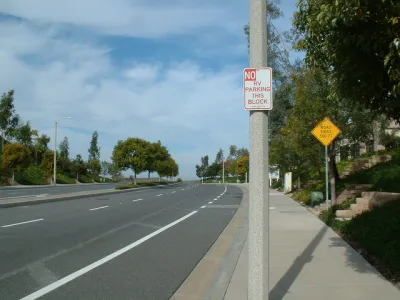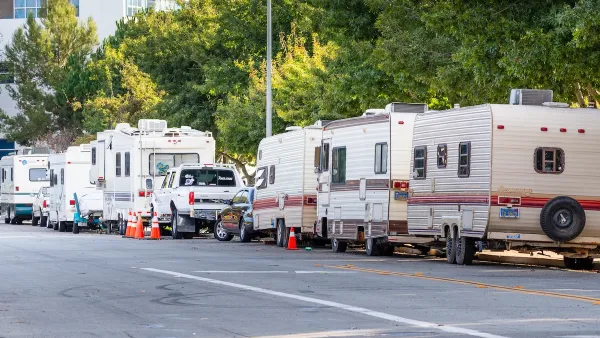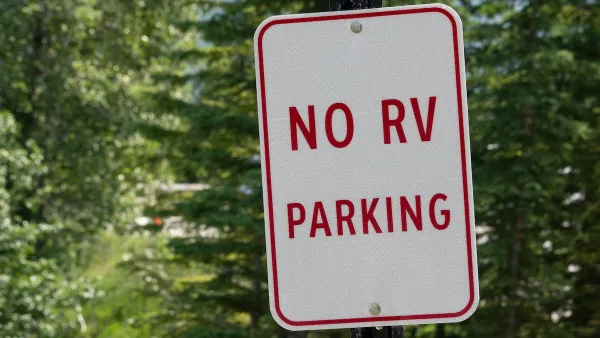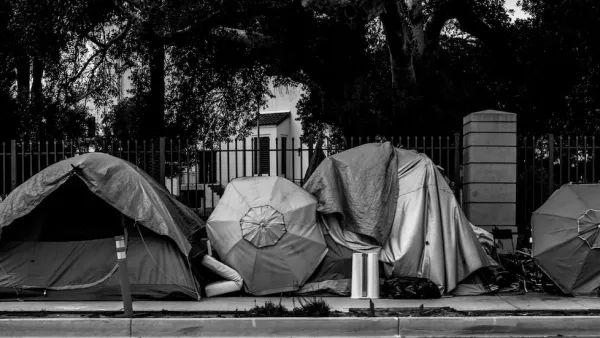Coastal cities are taking a no-tolerance approach to RVs on their streets, even as they otherwise strive to mitigate and prevent homelessness.

Although policies aimed at punishing or pushing out homelessness have long been decried by advocates, many cities are still—or even increasingly—pursuing them, according to journalist Kate Wheeling. In Pacific Standard, Wheeling highlights the problem as it manifests in Santa Barbara, California—where more than one-third of homeless residents live in RVs, and where "decades of cat-and-mouse games with city officials have made it nearly impossible for RV dwellers to find a place to park their homes."
Many cities justify RV bans with the untested assumption that parked RVs will lead to accidents by blocking drivers' line of sight. But some, including Santa Cruz and Los Angeles, have seen their bans overturned by lawsuits or by the state Coastal Commission for specifically targeting homeless people. Of Santa Barbara's ban, for example, Wheeling writes:
In the fall of 2016, a fed-up city council took more comprehensive action, voting unanimously to pass an ordinance banning on-street parking citywide for all oversized vehicles more than 25 feet long, 80 inches wide, or 82 inches tall. Unless, of course, that oversized vehicle is a government or utility vehicle, a contractor's pick-up, a commercial delivery truck, or a resident's or tourist's RV with the proper temporary permit. In other words, the new ordinance, which will go into effect in September, may not explicitly or exclusively describe RVs like Linda's, but no one is under any illusions about who the intended target is.
FULL STORY: DRIVEN OUT

National Parks Layoffs Will Cause Communities to Lose Billions
Thousands of essential park workers were laid off this week, just before the busy spring break season.

Retro-silient?: America’s First “Eco-burb,” The Woodlands Turns 50
A master-planned community north of Houston offers lessons on green infrastructure and resilient design, but falls short of its founder’s lofty affordability and walkability goals.

Delivering for America Plan Will Downgrade Mail Service in at Least 49.5 Percent of Zip Codes
Republican and Democrat lawmakers criticize the plan for its disproportionate negative impact on rural communities.

Test News Post 1
This is a summary

Test News Headline 46
Test for the image on the front page.

Balancing Bombs and Butterflies: How the National Guard Protects a Rare Species
The National Guard at Fort Indiantown Gap uses GIS technology and land management strategies to balance military training with conservation efforts, ensuring the survival of the rare eastern regal fritillary butterfly.
Urban Design for Planners 1: Software Tools
This six-course series explores essential urban design concepts using open source software and equips planners with the tools they need to participate fully in the urban design process.
Planning for Universal Design
Learn the tools for implementing Universal Design in planning regulations.
EMC Planning Group, Inc.
Planetizen
Planetizen
Mpact (formerly Rail~Volution)
Great Falls Development Authority, Inc.
HUDs Office of Policy Development and Research
NYU Wagner Graduate School of Public Service





























